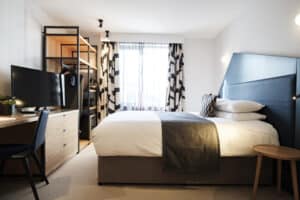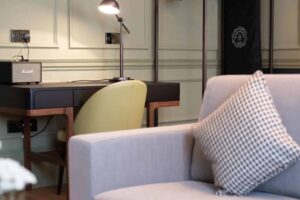Colour is one of the most powerful tools in design, especially when it comes to shaping our mood and emotional well-being. Rooted in psychological principles, colour has the ability to evoke memories, stir emotions and subtly shift our mindset, often without us even realising it.
Colour in influences mood, behaviour and perception
Colour psychology plays a vital role in interior design, and when we’re working in the hospitality sector, we use it to create emotive and memorable guest experiences. As designers, we use colour strategically to influence mood, behaviour and perception from the moment a guest enters the lobby.
Warm tones like terracotta, ochre and coral can evoke a sense of welcome and comfort, ideal for communal spaces, while soft blues and greens in bedrooms and spas, where calm, restfulness and restoration are priorities.
Neutral palettes, such as beige, taupe and charcoals form the backbone of many luxury hotel interiors, offering a sense of understated elegance and allowing accent colours to shine. Bold, saturated colours are increasingly being used to create immersive experiences, particularly in boutique hotels aiming for a strong identity and design moments worth capturing.
Remember colours have cultural contexts
Cultural context also matters – whilst red may suggest romance or energy in one culture, it may signal danger in another. In the UK, deep purple and gold has long been associated with royal occasions whereas in Brazil, purple relates to death and mourning and is usually avoided in celebratory contexts.
Lighting, texture and finish all influence how colours are perceived in real life. A black gloss finish looks and feels very different to a matt black finish. Ultimately, a successful hotel interior uses colour to tell a story, reinforce brand identity, and guide emotional response, creating environments that guests not only remember but want to return to.
We look to our own Devon coast for unique inspiration
Here in coastal Devon, summer brings a unique palette of inspiration: soft sea mists, warm sands, sun-bleached cliffs and rolling green hills. As designers, we draw from this natural beauty to create spaces that feel uplifting, calm and deeply connected to their surroundings:
- Lighter tones of soft whites, sea-glass blues, sandy beiges and pastel pinks enhance natural light and opens up a space, echoing the gentle brightness of a Devon morning. These colours help us feel cool and refreshed, even during the warmer days.
- Warm accents like coral, peach, and golden yellow reflect the glow of a beach sunset or wildflower bloom, bringing energy and a playful summer spirit. Used thoughtfully, these tones lift a space without overwhelming its serenity.
- Cool hues such as aqua, mint, and seafoam mirror the nearby coastline and the tranquil rhythm of the sea. Subconsciously, they calm the mind and body, lowering perceived temperature and invite stillness.
Colour psychology goes beyond aesthetics; it plays a central role in how we approach design. Every colour choice we make is intentional, aimed at shaping how a space feels, functions and supports wellbeing. Whether we’re drawing from the soft tones of the Devon coast or responding to a client’s emotional needs, we use colour to create inviting spaces that tell a deeper story.




